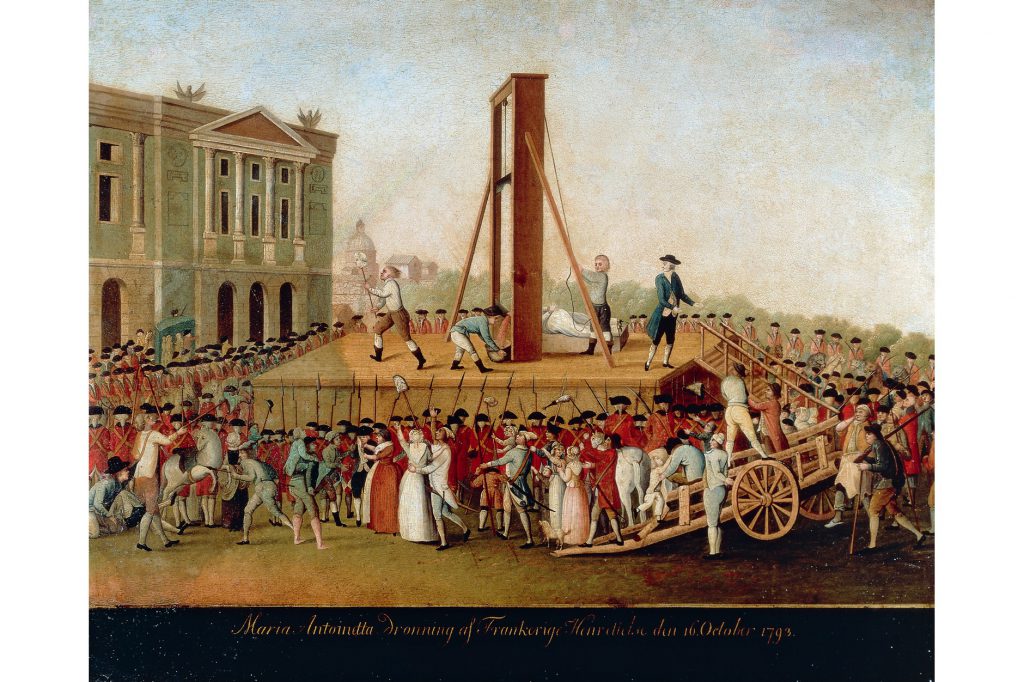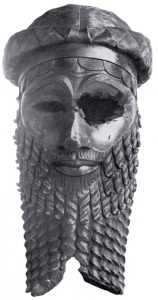
Two and a half months before her execution, at two in the morning, the Queen along with her daughter and sister-in-law were suddenly awakened and informed that the Queen was to be transported to the prison of Conciergerie. Without protest, Marie Antoinette got dressed and bid farewell to her family members. Then, without looking back, she left the temple. Fifteen minutes later, the Queen arrived in front of the grim towers of the Conciergerie, where she was registered under the name of “The Widow Capet” and became its 280th prisoner.5 She was led by the jailers to her new quarters. It was a dungeon of fifteen square meters with walls covered with an old cloth stained by humidity. It also had a narrow window at ground level that let in a pale light. Her only furniture consisted of a camp bed, two straw seat chairs, a convenience chair, and a bidet. Only a screen shielded her from the gaze of her guards and gave her no privacy at all. An assigned maid did everything she could to improve the Queen’s conditions during captivity.6

Alexander de Rougeville was loyal to the Republic at the beginning of the revolution; however, after he witnessed the Queen’s misfortune, he decided to help her to freedom. He had formerly been part of the Comte de Provence’s military establishment and was one of the officers who had protected her on June 20, 1792. That day, angry mobs broke into the Tuileries and forced the King to acknowledge the Republic. In addition, Marie Antoinette was insulted and called a traitor of France. In early September, he accompanied the royal family’s jail administrator Jean-Baptiste Michonis to the Conciergerie with two carnations pinned to his lapel. A plan called the Carnation Plot was attempted to aid the Queen to flee the country. Marie Antoinette picked up the flower and inside, the petal concealed a tiny note, which the Queen attempted to answer by pricking out a message with a pin. However, the gendarme on duty noticed her actions, took the incriminating evidence, and gave it to his immediate superiors. The name of the plot was taken from a flower that a certain Rougeville dropped at the Queen’s feet in her cell. The idea was for Marie Antoinette to escape to the château of Madame de Jarjayes. She was the Queen’s lady in waiting and her husband was General de Jarjayes, a loyal follower of the royal family. The Queen would then be transported to Germany, which was under the rule of Austria, Marie Antoinette’s homeland. The plot failed, but before the Republic could send the guards to capture him, Rougeville managed to escape.7
In the former Grand Hambre of the Palais de Justice, the Queen of France appeared before the Revolutionary Tribunal dressed in black and wore a widow’s bonnet in white lawn and trimmed with black mourning crepe. The Republic gave her lawyers less than a day to prepare a defense. One of the accusations against her was that she had been one of the instigators of the Champ-de-Mars massacre of July 1791, and that she had sent money out of the country to her brother, the Holy Roman Emperor. In addition, she was accused of scandalous conduct with her son, and that she had instigated most of the crimes that Louis XVI had committed. Marie Antoinette refused to respond to any charges. However, Marie Antoinette believed that she was innocent of these crimes and did everything within her power to save the monarchy as she conceived it. The entire trial started from October 15, 1793 at eight in the morning and ended on October 16 at four-thirty in the morning.8

On October 16, 1793, at four-thirty in the morning, Marie Antoinette was declared guilty of the three main charges of having secret agreements with foreign powers, of shipping money aboard to Austria, and of conspiring with these powers against the security of French. After ten weeks in the Conciergerie, the Queen’s incarceration came to an end. She was sentenced to death by guillotine and yet she remained impassive and simply shook her head at the verdict. As stated by Chauveau-Lagarde, Marie Antoinette showed true courage and was void of any negative emotion.9 Once returned to her cell, the Queen wrote a farewell letter to Madame Elisabeth, her sister-in-law. During the preparation for her execution, Rosalie witnessed the planned humiliation carried out on Marie Antoinette. First, she was obliged to prepare herself under the gendarmes’ watchful eyes. When she attempted to undress in a little niche between the wall and the bed, she signed to Rosalie to shield her. However, one of the men came around and stared at her. The humiliation continued when Charles Henri Sanson came and hacked off her thin white hair with enormous scissors. Marie Antoinette was also told her hands must be bound, even though the late Louis XVI hadn’t had his hands bounded. The next humiliation occurred when she was overcome with weakness and asked to have her hands unbound and squatted in the corner. Having relieved herself, she meekly held out her hands to have them bound again.10
The day was fine and slightly misty, as huge crowds lined the route to the Place du Carrousel’s guillotine and listened to the cries of the escort: “Make way for the Austrian woman!” and “Long live the Republic!”11 Mainly the crowd heard these cries with satisfaction. By the time the cart reached the Place du Carrousel, she was sufficiently in command of herself to step down easily. Stepping lightly “with bravado,” she sprung up the scaffold steps despite her bound hands, and paused only to apologize to her executioner for stepping on his foot.12 So she went willingly, even eagerly, to her death. The head of Marie Antoinette, desired by the leaders of the French Revolution, was cut off cleanly at 12:15 on Wednesday, October 16, 1793, and was exhibited to a joyous public.
On the very day of the execution, the Queen’s mutilated body was taken to the small cemetery of the Madeleine, where the King’s body had been left nine months earlier. On November 1, a gravedigger buried the Queen’s remains and sent the following note to the multiple authorities. “The widow Capet. 6 livres for the coffin. 15 livres, 35 sols for the grave and the gravedigger.” These words described the funeral of the last Queen of France.13 With the restoration of the monarchy, on January 18, 1815, the remains of the royal bodies were exhumed with the help of Pierre Louis Desclozeaux, an old lawyer who lived at 48 rue d’Anjou. He remembered the two interments and had subsequently tended the sites. He created a garden out of the area and planted two weeping willows as a commemoration. The bodies were then briefly held at the house in the rue d’Anjou. Prayers were said before they were sealed in new coffins with appropriate inscriptions of the majesty and titles of the occupants. On January 21, 1815, a formal procession led the coffins to the Saint Denis cathedral.14 Commemorative statues of Louis XVI and Marie Antoinette were built in the cathedral and their remains were reburied in the Bourbon vault.15
No longer considered one of history’s greatest criminals, the last Queen of France today arouses interest and compassion. After her death on the scaffold, Marie Antoinette entered the world of legend and became a mythical figure.16 Being a scapegoat for the revolution, the Republic’s political decision for her execution united France. Despite being a sacrifice for the French, she never lost her composure and retained her image as a dignified Queen until the last moment of her life.17
- Evelyne Lever, Marie Antoinette: The Last Queen of France (NY: Farrar, Straus and Giroux, 2000), 304-305. ↵
- Evelyne Lever, Marie Antoinette: The Last Queen of France (NY: Farrar, Straus and Giroux, 2000), 213. ↵
- Evelyne Lever, Marie Antoinette: The Last Queen of France (NY: Farrar, Straus and Giroux, 2000), 250-259. ↵
- Evelyne Lever, Marie Antoinette: The Last Queen of France (NY: Farrar, Straus and Giroux, 2000), 287-290. ↵
- Evelyne Lever, Marie Antoinette: The Last Queen of France (NY: Farrar, Straus and Giroux, 2000), 291-292. ↵
- Evelyne Lever, Marie Antoinette: The Last Queen of France (NY: Farrar, Straus and Giroux, 2000), 292. ↵
- Evelyne Lever, Marie Antoinette: The Last Queen of France (NY: Farrar, Straus and Giroux, 2000), 293-294. ↵
- Evelyne Lever, Marie Antoinette: The Last Queen of France (NY: Farrar, Straus and Giroux, 2000), 299-304. ↵
- Antonia Frazer, Marie Antoinette: The Journey (NY: Doubleday, 2001), 435-438. ↵
- Antonia Frazer, Marie Antoinette: The Journey (NY: Doubleday, 2001), 438-440. ↵
- Antonia Frazer, Marie Antoinette: The Journey (NY: Doubleday, 2001), 439. ↵
- Antonia Frazer, Marie Antoinette: The Journey (NY: Doubleday, 2001), 440. ↵
- Evelyne Lever, Marie Antoinette: The Last Queen of France (NY: Farrar, Straus and Giroux, 2000), 305. ↵
- Antonia Frazer, Marie Antoinette: The Journey (NY: Doubleday, 2001), 447. ↵
- Antonia Frazer, Marie Antoinette: The Journey (NY: Doubleday, 2001), 457. ↵
- Evelyne Lever, Marie Antoinette: The Last Queen of France (NY: Farrar, Straus and Giroux, 2000), 308-309. ↵
- Antonia Frazer, Marie Antoinette: The Journey (NY: Doubleday, 2001), 453. ↵




80 comments
Brittney Carden
I honestly have never heard of the story of Queen Marie Antoinette. While reading this article I couldn’t help but ask myself, was killing the royal family necessary? I would like to say that it was not necessary to execute the members of the royal family. They had already given up, and they were trying to escape the country, focused on saving their own lives. But, I guess I do understand why the leaders of the revolution wanted to execute them. It was definitely a show of power and also symbolic to their movement. With the royal family being taken care of, there was no one else in their way. They wouldn’t have to worry about them rallying troops and people to their cause and coming back for revenge, it was over.
Emilia Caballero Carmona
Hey Amelia, your article is so well written and interesting to read! I enjoyed reading your article because it is so informative and detailed and not confusing at all. I remember learning about the execution of Marie Antoinette and her entire family in high school, I was in shock because I couldn’t believe they had killed them to end their reign.
Andrea Laguna
Captivating article! Before reading your article, I knew Marie Antoinette just as a French queen that was beheaded by the guillotine. Now that I have read the article, I see her with a whole different light. I get to see her as a brave women that, even though she was put into prison unjustly and endured humiliating acts, she never lost her composure and represented the monarchy with elegance. I can’t stop thinking what the outcome of France would’ve been if her late husband, King Louis XVI, wouldn’t have doubt her judgement of taking refuge in the town of Metz.
Monserrat Garcia
As this article mentions, the last Queen of France is a historical figure. Everyone has heard of her but not many know of her or her story. This article is extremely well written and explains everything in a way that the story and history is easy to grasp. I did not know of her execution story but now want to learn more about even her daily life. This article got me interested in something I thought I would have never been intrigued by… The fact that she was actually innocent just leaves me thinking of all the innocent people that have and still are being executed to this day.
Jake Faryniarz
This was a very interesting article about Queen Antoinette and how she was executed by the French people for crimes against the Revolution. It is surprising to me how they used her as a scapegoat to blame all the problems on her since she was apart of the royal family. Even though she was actually innocent of her crimes. She was humiliated and went through hard struggles because of how the French treated her. It is also interesting to see how people back then dealt with political issues and seemed to just blame the person in power and execute them to create a new system of government. This article was well written by the author and enjoyed learning from it.
Kandi
She was not only innocent of her crimes she worked with the Moderate Constitutionalists and did everything they asked her to do for 4 to 6 months until the radicals started taking over. She worked in secret with Barnave and two others ( a triumvirate) who were working on the Constitution and then she worked with Louis to help him accept the new Constitution. She was extremely intelligent and wanted to do everything she could to help the people and bring peace.
Look up the letters of Marie Antoinette to Von Fersen and Barnave. Read “ The Making of a French Queen “. Someone should do a movie on that and give her credit where credit is due.
Because of Louis exiled brothers, ( mainly Artois ) the emigres and radicals everything fell apart. It was only at the very last that they tried to rely on outside help because the radicals were responsible for everything falling apart.
She was young when she made mistakes but if people would do their due diligence they would learn not everything was as it seemed.
Louis XV mistress’s ( Pompadour and Du Barry ) and family spent much more than she did.
She also supported the doubling of the Third Estate but that got out of hand and she regretted it later.
She really tried, she did more than Louis to work with the moderates. He had a breakdown of sorts.
I have also read one of the first biographies written dating back to 1896 written by the son ( I believe of the son of someone who knew her)
It’s sad that most people prefer to believe the same narrative over and over. No one wants to dig deeper.
Yaniev Ibarra
I had never known about the captivity of Marie Antoinette, but I had heard of her. This article does a well job at outlining how she managed to keep her dignity and do everything she could to represent the monarchy well. She was a noble queen that had to face terrible accusations and in addition humiliation. It impresses me how even up until moments before being executed she still managed to comply and even apologize to one of the executioners for stepping on his foot. Her actions justify just how brave she was.
Alyssa Ramos
This is an interesting article to read. I have heard of the name Marie Antoinette plenty of times, but I never knew about her execution. She was involved in terrible accusations and went through humiliation. It is crazy how they found Marie Antoinette innocent after it was too late, and she was already dead. She seemed compliant but brave after she put her hands together to be bound again.
Kayla Mendez
Despite having an entire revolutionary organization against her, and experiencing constant humiliation, Marie Antoinette did everything in her power to represent the monarchy well, which I believe she accomplished. No matter the circumstances that were thrown at her, she managed to keep her dignified reputation, even until moments before her death. I appreciate the author’s addition of her second burial, for it symbolized a happy ending for the noble Queen.
Adrianna Hernandez
This was a very informative article! I had never heard about Marie Antoinette so I was surprised to find out that she was executed. I think that events could have ended differently if dealt with in a different way and with a different perspective. I always find it interesting to learn how problems were handled in the past in comparison to now. It surprised me to read that she remained poise and kept her image through it all.
Janaya Felder
I know just a little about Marie Antionette from studying about the chef Marie Antoine Carême who was named after her. It’s so sad to see how she was treated leading up to her execution, yet somehow she composed herself in a royal manner knowing she was going to die. I think it’s unfortunate that the French revolution thought it best to expunge the royal family even though some of them, like Marie Antionette, were/might have been innocent.